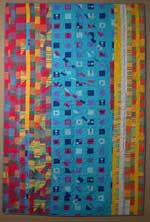Radka Donnell: The Work of Touch
Friday, February 7, 2003 to Friday, March 7, 2003
Radka Donnell’s quilts break many of the rules that have governed how quilts were designed and made for much of the last two hundred years and longer. They pay little heed to grids or to symmetry. Their colors are riotously and impulsively juxtaposed. They eschew fine stitching in favor of the functional and the no-nonsense. They avoid the familiar small-scale, genteel prints normally associated with quilts in favor of large-scale, graphically assertive patterns. The bold surfaces of these fabrics compete with and against one another, in frenetic dances of exaggerated visual energy.
In this respect they challenge many of the compositional rules of formalist art in general. It is this daring to risk appearing visually eccentric or uncontrolled or anarchic that makes Radka Donnell’s quilts so compelling and unforgettable.
Apart from their singular and idiosyncratic surface treatments the artist sees in her quilts testaments of identity, connection and healing. They become embodiments of the struggle, across time and generations, across gender, across race and ethnicity, to map out a pathway for the self that is compassionate, loving, inclusive and deeply human. The scale of most of these works reinforces that intent: almost all comfortably accommodate a full reclining adult form, and this embrace of cloth and the body affirms the artist’s humanist perspective. “The body is mortal, it is the site of danger…” she writes in Quilts as Women’s Art. “…it is not one’s own creation but the work, at the start, of two authors.” The physicality of the body, and of its origins in the most physical of acts, is never far from Donnell’s conception of what a quilt is.
For the most part the traditional quilt acknowledges the primacy of mathematical order and the logic of interrelated squares, rectangles and triangles. It’s not by accident that quilts are so often evoked when visual metaphors for the partitioning of the land, especially the rural landscape, are needed. Quilts may be women’s art, but their structural organization almost always conforms to a purview ascribed to the male sensibility: square corners, straight furrows, neat and precise rows and ever-continuing multiples. The view from above onto the endless mid-American landscape, stretching neatly and orderly to the horizon.
The designs of Radka Donnell’s patchwork surfaces rarely conform to any mathematical limitations or formulas. Rather, their buoyant and exuberant energies flow out of a calculated disregard of the predictable and the containable. They may be maps, but the territories they describe and record are not those of the visible world. Instead, they bear witness to the inner psychic world of separation, loss, anxiety, difference and eventual redemption that qualifies each human life.
Finally, Radka Donnell’s works are about touch, and the tactile quality and appeal of the quilt has rarely been so palpable as it is in these constructions. “Quilts are touchable,” she writes, “they are made by touch. They refer doubly to the body, itself touchable and touching, to the person as a body and the body of a person…The eminently hospitable, comforting, and enveloping nature of cloth and quilts – their purpose and their substance – make the quilt a solacing object. Quilts recall and embody the first and greatest solacing agent in our lives: our mothers.”
This connection to the maternal is the fundamental, even elemental, link that connects every quilt ever made, and Radka Donnell’s quilts beautifully epitomize that association. They bridge the divides that have isolated high art from low, fine art from craft, women’s work from male industry, and in their mediating capacity they create a visual expression of affirmation, strength, and reconciliation.
- Michael James, Curator ©2003

